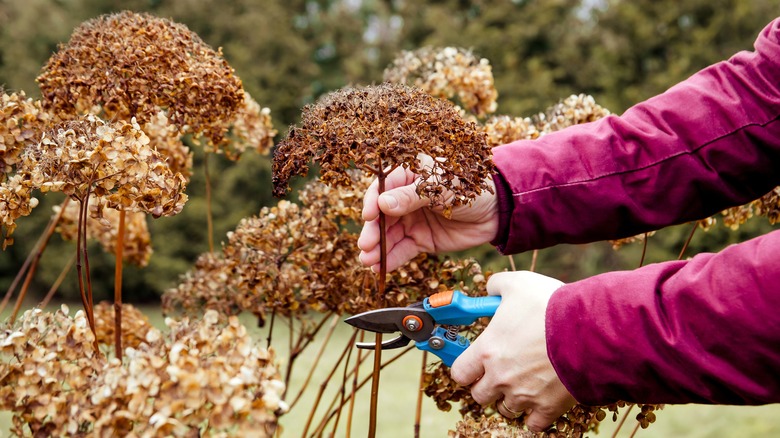Of the different types of hydrangeas most commonly grown in the United States, two terms used to refer to them are “new wood” or “old wood” hydrangeas. These terms refer to how buds form on stems: new wood means buds form on new stems, and old wood means buds form on old growth stems. The main benefit to growing new wood hydrangeas is that, unlike their old wood counterparts that bud in the fall, their flower bud formation occurs in spring. This makes them less vulnerable to a late spring frost and easier to prune and grow.
New wood hydrangeas are sturdy and long-lived, with some varieties growing up to 10 feet tall and wide. They can also be trained as trees. Their flowers grow in large round or cone-shaped clumps, appearing in summer and remaining vibrant through autumn. Small hydrangea varieties like lacecap combine tiny and large flowers on the same clump.
Two new wood varieties, panicle and oakleaf hydrangeas, have a color range of pale green to creamy white to rosy pink over the season, though some newer cultivars have a wider color range. Because their bloom colors are not affected by soil pH, the coloring of new wood hydrangeas remains the same consistently year after year. The flowers can be dried or preserved on their stems, similar to bigleaf hydrangea flowers. These hydrangeas are also much easier to prune than their “old wood” cousins.
Pruning new wood hydrangeas

New wood hydrangeas are also easier to prune than old wood hydrangeas, mainly because there is less guesswork about when and how much to prune. Since buds only form in spring, cutting down these shrubs in the fall will not affect the flowering time the following year. These hydrangeas are also cold hardy to zone 3 or 4, depending on the variety, meaning they’re a great choice for regions with cold winters.
These hydrangeas also tend to put out new growth a lot faster than old wood hydrangeas, so you will want to keep an eye on them as they will sometimes start to spread. Pruning them back in the spring, summer, or fall helps to keep them at a reasonable size. You can also easily divide hydrangeas in the fall and replant the sections that have roots attached. Be sure to add some good soil and compost when you replant them to give them a good start.
When pruning these hydrangeas in the spring, look for any new buds that have started to form. Although these shrubs will continuously put out new buds through spring and into summer, cutting branches with new buds means you may have slightly fewer flowers. However, pruning also stimulates new growth, so trimming away any dead or damaged branches will help new ones to form.
Which new wood hydrangeas to choose

New wood hydrangeas tend to have two different shapes to their flower clumps: ball-shaped or cone-shaped. The ball-shaped ones produce rounded flower heads covered in small, or lacecap, flowers. The cone-shaped ones (which occur on both panicle and oakleaf hydrangeas) can have both small or large flowers, depending on the variety. Both shapes are attractive and flower for weeks in summer into fall, when they shift color from green to cream to rose pink and sometimes back to green again.
Some larger ball-shaped flowers may get heavy in full bloom, so you can cut them to keep the shrub looking neat. They are a very long-lasting cut flower. Some popular panicle hydrangeas with ball-shaped flowers include Annabelle, Puffer Fish, and Incrediball. Popular varieties with cone-shaped panicles include Limelight (named for their gorgeous lime green flowers in spring), PeeGee, Pinky Winky (which turns a rosy pink in late summer), and Quick Fire. Check the details on labels or on mail-order sites before purchasing your panicle hydrangeas to make sure the mature size and growing zone are compatible with your garden.
Once your hydrangea’s flowers begin to dry on the stem, you can leave them for winter interest or prune them back. These dead flower heads can be pruned either in the fall or in the spring. A light layer of natural pine mulch in late fall helps protect the roots of your hydrangea in winter.



